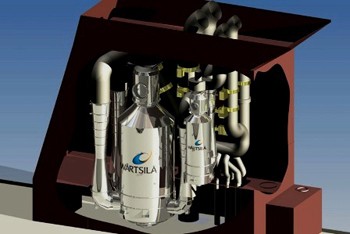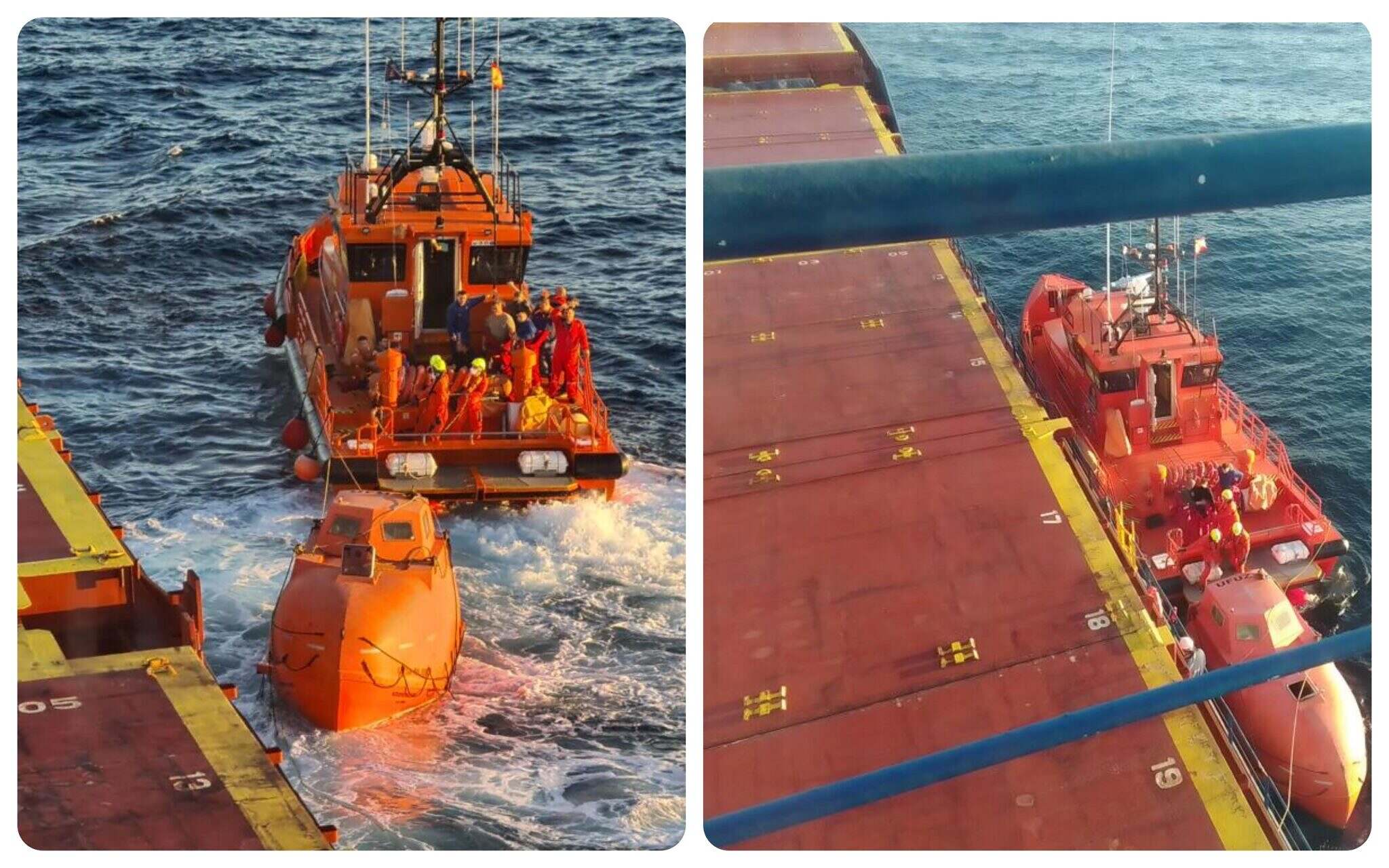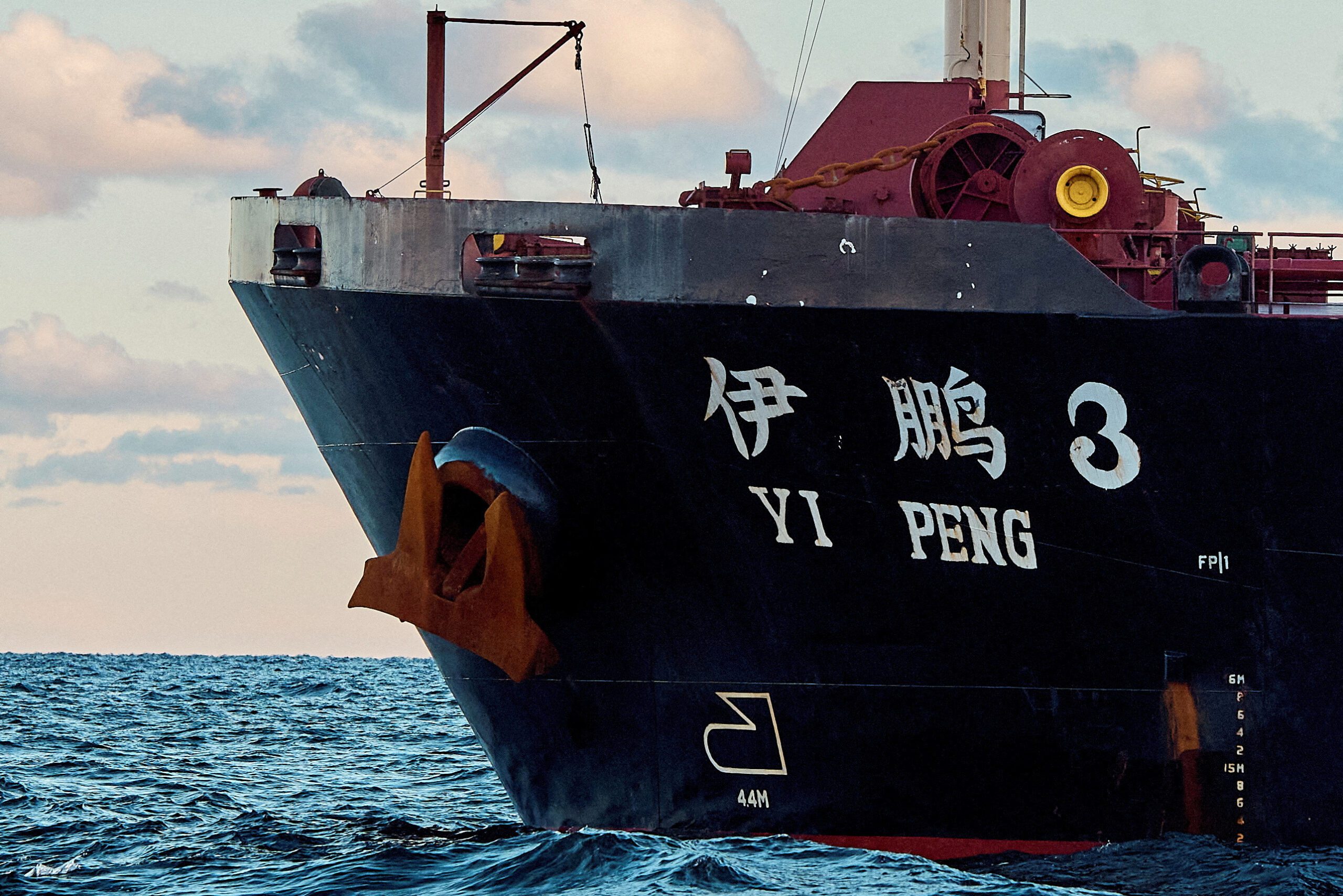Hybrid exhaust scrubber, image: Wartsila
Over the last few years, the exhaust gas cleaning system (EGCS) / scrubber market within the maritime industry has accelerated and with it so has scrubber technology innovation.
However, the scrubber market is still far from ‘booming’. Current air emission legislation and fuel cost differentials do not necessarily make the economics attractive right now. It would appear that the imminent tightening of sulphur regulations across Emission Control Areas (ECAs) in 2015 and the impending global sulphur cap shift planned for some years later is spurring the most impact on the market.
Hamworthy Krystallon announced what they stated to be the first commercial order for a maritime scrubber in 2010. Wärtsilä (who also now own Hamworthy Krystallon) followed suit a couple of months later with a parallel announcement of an order. By mid-2012 Wärtsilä declared that they had received around twenty orders.
As another indicator for market expansion, the benchmark for the largest scrubber installation has also shifted three times in about as many years: from 21MW in 2009, to 28MW in 2012, to 32MW in 2013.
In the midst of this, although new players continue to enter the market, there is also significant consolidation of existing technology providers. If uncertainly on the exact future requirements of the regulation was not enough, these changes in key market players and company ownership are also likely to impact to the future development of this market.
This week, Fathom looks at key acquisitions and new entrants in the scrubber market over the last couple of years and the innovative solutions that new companies within the market space provide.
Acquisition: Wärtsilä and Hamworthy
Wärtsilä acquired Hamworthy in 2012.
Wärtsilä is a global power solutions and services company for the marine and energy markets. Within the maritime market their broad offering covers the complete lifecycle of a vessel from initial ship design to daily propulsion and operating requirements. Wärtsilä currently employs some 18,000 people working from 170 locations in 70 different countries, with net sales of €4.2 billion in 2011.
Hamworthy is a global engineering company headquartered in Britain providing specialist equipment and services to the marine, oil & gas and industrial sectors. The company employs approximately 1000 people worldwide with offices in Europe, the USA, Asia, the Middle East and India. Hamworthy generated revenue of £181.6 million in 2011.
In terms of scrubber technology, Hamworthy had previously acquired the business and assets of Krystallon in September 2009. Krystallon was a joint venture between BP Marine and Kittiwake formed specifically to develop maritime scrubber technology. An open loop seawater system; the first Krystallon exhaust gas cleaning system was fitted to the Pride of Kent a P&O ferry in 2006 with its first commercial order coming in 2011.
By acquiring Hamworthy Krystallon, Wärtsilä was in fact adding to it’s own maritime scrubber solutions that Wärtsilä itself had developed. At the time of acquisition, Wärtsilä outlined the benefits of the deal:
“The combining of the two companies’ strengths will speed up and ease the means for customers to reduce operating costs and achieve compliance with environmental legislation. It also further facilitates ‘one-stop’ procurement procedures for shipyards to reduce risks arising from having multiple suppliers.”
Wärtsilä – Hamworthy Scrubber Systems
Through each having previously developed different systems, the combined Wärtsilä – Hamworthy group offers a comprehensive range of exhaust gas cleaning systems. These include seawater-only open loop systems, freshwater and chemical closed loop systems and hybrid systems. The scrubber units are applicable to both new-builds and retrofits and 2-stroke of 4-stroke engines as well as oil-fired boilers.
For the group, the first commercial order was for the Wärtsilä (previously the Hamworthy Krystallon) open-loop scrubber unit in 2010. It was installed on the RoRo vessel Linea Mesina in 2011 as part of an order for four RoRo vessels operating within European waters. Prior to this unit being installed, the Hamworthy Krystallon open-loop systems had achieved more than 49,000 hours of logged testing.
Installations of the Wärtsilä closed-loop scrubber unit have also seen great uptake over the last few years. The first delivery was made in August 2011, in a retrofit of the vessel Containerships VII which contained a Wärtsilä W7L64 engine. At the end of 2012 however, the company claimed a reference totalling more than over 20 installations with further orders on the books.
Their integrated freshwater scrubber is currently being installed on eight new-build bulk carriers owned by Algoma which are due to be delivered in the first half of 2013. These will operate on North America’s Great Lakes.
The hybrid scrubber system is currently being retrofitted on the RoRo vessel MV Tamesis, owned by Wilh. Wilhelmsen ASA, and is due to be delivered as part of scheduled dry docking in the first quarter of 2013. This will be is said to be the world’s largest single multi-stream scrubber installation, and will treat the exhaust gases of a 28MW engine.
Following commissioning, a comprehensive third party measurement and verification programme will be carried out over two and a half years.
Wärtsilä received a repeat order for the hybrid scrubber system in December 2012 and earlier this week announced another repeat order from Ignazio Messina & Co. This order is for installations on four container RO/RO vessels that the STX Offshore & Shipbuilding shipyard in South Korea is building. The ships are scheduled for delivery in the second half of 2014.
The company is also developing concept ship designs with integrated scrubber systems. The first such design was launched for Aframax tankers in October 2012.
Acquisition: Alfa Laval and Aalborg
Alfa Laval acquired Aalborg Industries for over USD $770 million in 2011.
Alfa Laval is a leader in heat transfer, centrifugal separation and fluid handling, and has long-standing expertise in providing services to a number of industries, including the marine and offshore markets. The company has approximately 12,000 employees, with sales offices in more than 50 countries, and generated revenue of USD 4.3 billion in 2011.
Aalborg Industries is an equipment and service supplier in the marine sector and a supplier of industrial products to selected key markets. The company is headquartered in Denmark, has around 2,600 employees and generated revenue of USD $620 million in 2010.
According to Alfa Laval, Aalborg adds a strong product offering which focused on energy efficiency. This offering includes boiler systems, thermal fluid systems, waste heat recovery systems and inert gas systems. Although Aalborg sells mainly to the marine and off-shore markets, it has an increasing exposure to the power industry as well as to other industrial end markets.
Alfa Laval has a strategy to undertake acquisitions and alliances that strengthen the existing key technologies by adding new solutions as well as complementary products and distribution channels.
Over the last five years, Alfa Laval has acquired some 28 companies with total sales of these companies at the time of the acquisitions amounting to approximately USD $1.3 billion.
“Aalborg Industries complements our offering of energy-efficient and environmental solutions. It represents a significant business opportunity as it not only supports the development of our offering to the marine and off-shore markets but also means we can introduce their product offering to new industrial end markets and customers.” stated Lars Renström, President and CEO of the Alfa Laval Group.
Alfa Laval Aalborg Scrubber Systems
Originally developed under Aalborg, Alfa Laval offers the PureSOx hybrid function scrubber. It can use either an open loop system with seawater substrate or a closed loop with freshwater substrate. This means that in port, the scrubber can use the closed-loop system to operate with zero discharge, whereas at open sea the scrubber can be run on saltwater, giving lower costs and easier operation.
The first test unit was installed on the RoRo vessel the DFDS Ficaria Seaways in 2009 and has since completed more than 4000 hours of operation. This was the world’s largest scrubber at the time of installation, treating a 21MW Man B&W engine and acting to reduce the effective sulphur content of the fuel from 2.2% down to 0.1% equivalent. The results of this trial were within the required parameters and were certified through continuous missions monitoring by the Danish EPA.
A second scrubber unit was retrofitted in 2012 onto the ConRo vessel M/V Plyca owned by German operator Spliethoff. This was the first vessel to utilize a single scrubber to clean the exhaust gases for the main as well as the auxiliary engines: a combined output of 28MW.
The PureSOx system is now commercially available and received its first order in January 2013. A confidentiality agreement meant it was unable to disclose the name of the customer however said that the order is worth approximately USD $9 million.
New Market Entrant: GreenTechMarine
GreenTechMarine (GTM) is a new technology provider in the scrubber market, having only been founded in 2010.
The company’s mission is to provide compact systems exhaust gas cleaning systems and energy-saving systems for the maritime industry. They are a sister company to Marine Global Group, an independent installation company that performs both mechanical and electrical installations for the marine industry worldwide.
GreenTechMarine Scrubber System
GreenTechMarine manufactures the GTM15 hybrid scrubber system, a wet exhaust gas cleaning system that employs both open loop and closed loop technology. The system is said to be uniquely compact, with a small size and low weight.
GreenTechMarine scrubbers replace onboard exhaust silencers and are suitable for both new-build and retrofit operations. According to the company, the scrubber can also act as an exhaust silencer outside of ECAs, meaning no increase in the weight or space requirements during installation. The unit is said to run on less than 1.5% of the power output of the main engine.
The pilot unit was first installed onboard the Royal Caribbean cruise ship Liberty of the Seas in the winter of 2011-12. This installation was unique in that it was carried out while the ship was still in service: prefabricated parts were carried onboard and assembled inside the engine casing. No steel modifications were required.
In January 2013, GreenTechMarine also announced that it would be delivering four scrubbers to Norwegian Cruise Line’s “Pride of America” in March 2013. The scrubbers will replace the ships exhaust silencers and clean the exhaust of four 8MW engines. This 32MW installation is the largest installation of scrubbers to date.
Watch This Space
As these mergers, acquisitions and new market entrants demonstrate, the maritime scrubber market is far from mature with further existing and emerging players excelling in the market. Although there has been significantly increased uptake over the last 18 months by historical comparison, when this is considered in context of the entire global fleet it is not even a scratch on the surface. The state of limbo that pervades the market for both ship owners and technologies manufacturers cannot continue indefinitely however, and developments in 2013/14 will hopefully start to indicate the future for the use of scrubbers in the maritime industry.
For more news and tips on shipping efficiency, please visit Fathom-cTech
Unlock Exclusive Insights Today!
Join the gCaptain Club for curated content, insider opinions, and vibrant community discussions.

 Join The Club
Join The Club











